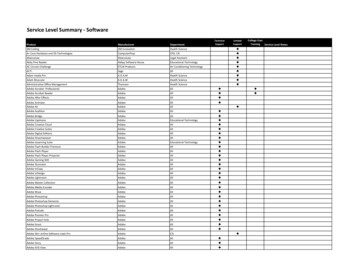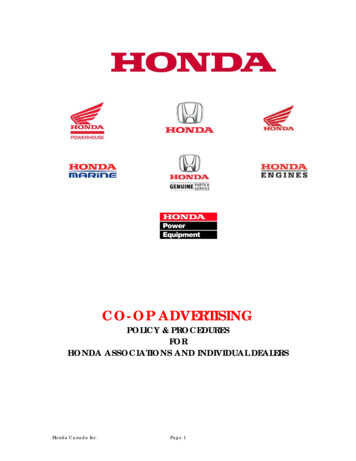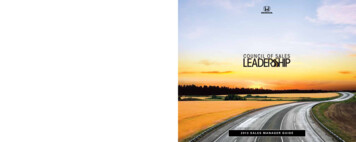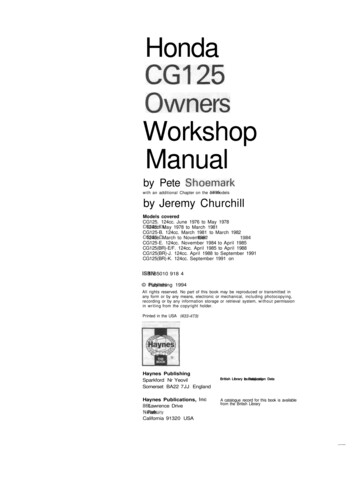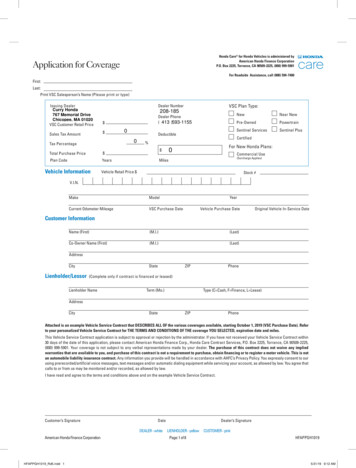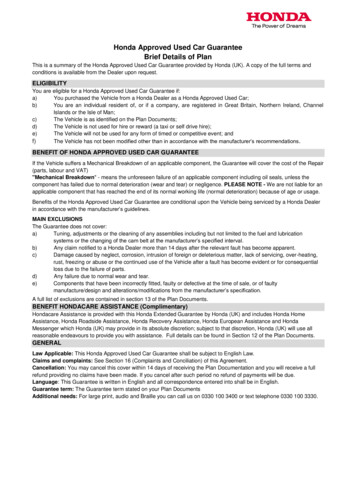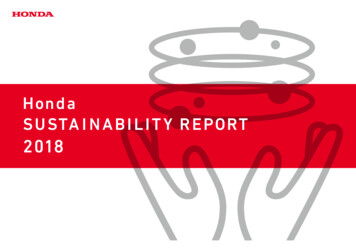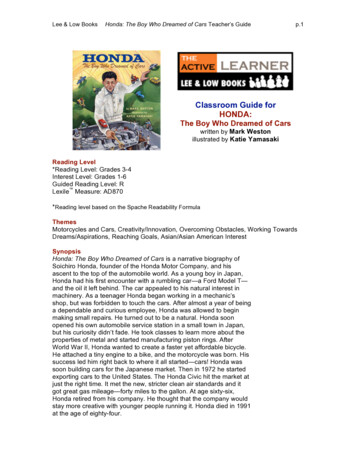
Transcription
Lee & Low BooksHonda: The Boy Who Dreamed of Cars Teacher’s Guidep.1Classroom Guide forHONDA:The Boy Who Dreamed of Carswritten by Mark Westonillustrated by Katie YamasakiReading Level*Reading Level: Grades 3-4Interest Level: Grades 1-6Guided Reading Level: RLexile Measure: AD870*Reading level based on the Spache Readability FormulaThemesMotorcycles and Cars, Creativity/Innovation, Overcoming Obstacles, Working TowardsDreams/Aspirations, Reaching Goals, Asian/Asian American InterestSynopsisHonda: The Boy Who Dreamed of Cars is a narrative biography ofSoichiro Honda, founder of the Honda Motor Company, and hisascent to the top of the automobile world. As a young boy in Japan,Honda had his first encounter with a rumbling car—a Ford Model T—and the oil it left behind. The car appealed to his natural interest inmachinery. As a teenager Honda began working in a mechanic’sshop, but was forbidden to touch the cars. After almost a year of beinga dependable and curious employee, Honda was allowed to beginmaking small repairs. He turned out to be a natural. Honda soonopened his own automobile service station in a small town in Japan,but his curiosity didn’t fade. He took classes to learn more about theproperties of metal and started manufacturing piston rings. AfterWorld War II, Honda wanted to create a faster yet affordable bicycle.He attached a tiny engine to a bike, and the motorcycle was born. Hissuccess led him right back to where it all started—cars! Honda wassoon building cars for the Japanese market. Then in 1972 he startedexporting cars to the United States. The Honda Civic hit the market atjust the right time. It met the new, stricter clean air standards and itgot great gas mileage—forty miles to the gallon. At age sixty-six,Honda retired from his company. He thought that the company wouldstay more creative with younger people running it. Honda died in 1991at the age of eighty-four.
Lee & Low BooksHonda: The Boy Who Dreamed of Cars Teacher’s Guidep.2BackgroundSoichiro Honda’s success as an inventor and a businessman had itsroots in his childhood. His father was a blacksmith who instilled in hischildren a strong work ethic and a love of mechanical things. YoungSoichiro grew up to be an independent thinker, and his innovativebusiness practices were unusual in Japan, a country not known for itswillingness to accept nonconformity. In spite of this, Soichiro Hondapersevered. He created an automobile giant even though he faced theopposition of the Japanese government.Honda’s rise from humble beginnings to a powerful and influentialbusinessman is one of twentieth century’s most inspirational stories.More detailed information about Honda’s life and innovations can befound on the Honda website.Teaching TipHonda: The Boy Who Dreamed of Cars is an excellent book to use during a unit oninventors or as part of your observance of Asian American/Pacific Islander HeritageMonth in May.BEFORE READINGPrereading Focus QuestionsBefore introducing the book to students, you may wish to develop backgroundinformation, tap prior knowledge, and promote anticipation with questions such as thefollowing:1. What do you know about cars? What are some of today’s popular cars?2. When do you think the car was invented? Who invented it? How did people travelbefore cars existed?3. What advantages did cars have over earlier ways of traveling? What were thedisadvantages?4. Who are some of your favorite inventors? What did they invent? What skills andabilities do you think you would need to be a good inventor?5. What do you know about Japan? What do you think life is like there?Exploring the BookWrite the title of the book on the chalkboard. Ask students if they recognize the nameHonda. Where have they heard or seen it before? Then ask students to talk about whatthey think the subtitle means.Have students look at the illustration on the front cover. Invite them to comment on theimages.
Lee & Low BooksHonda: The Boy Who Dreamed of Cars Teacher’s Guidep.3Page through the book, noting features such as the title page, acknowledgments,sources, dedications, copyright, text, illustrations, and afterword.Setting a Purpose for ReadingHave students read to find out what motivated Soichiro Honda throughout his life andhow he created innovative motorcycles and cars.VOCABULARYHave students look up each of the following words and terms and then write their owndefinitions. Working in pairs, ask students to pretend they own cars and are havingdiscussions about their cars using the words and terms onloanhosespark plugpistonmileagebrakespiston ringengineAFTER READINGDiscussion QuestionsAfter students have read the book, use these or similar questions to generatediscussion, enhance comprehension, and develop understanding for the content.Encourage students to refer back to the text and illustrations in the book to support theirresponses.1. Where is Japan? What continent is it part of? What is its mostfamous mountain?2. What do you learn from the story about Honda’s natural curiosity?3. What was Honda’s first experience with cars? What effect did ithave on him?4. What was Honda’s first job with cars? What do you think theowner taught Honda by being so hard on him? What was Honda’smost important character trait in getting through his first yearworking for the mechanic?5. Why was Honda’s repair shop in Hamamatsu successful?6. What happened once Honda built the fastest racecar in Japan?7. What was Honda’s first step toward making his dream of buildingcars come true?8. During World War II what did the Japanese government wantHonda to manufacture? Why?9. What did Honda do to make his ride to work quicker? What did hisinvention lead to?
Lee & Low BooksHonda: The Boy Who Dreamed of Cars Teacher’s Guidep.410. What did Takeo Fujisawa do to help Honda start the Honda MotorCompany? What was Fujisawa’s role in the company?11. How was Honda hard on his employees? Why did he expect somuch? How was he good to his employees?12. When Honda began making cars for the United States, how didone of his engineers help him?13. What was the first car Honda sent to the United States? Was itsuccessful here? Why or why not?14. Why did Honda retire when he was sixty-six? How did he feelabout introducing new ideas into his company?Literature CirclesIf you use literature circles during reading time, students might find thefollowing suggestions helpful in focusing on the different roles of thegroup members. The Questioner might use questions similar to the ones in the Discussion Questionsection of this guide.The Passage Locator might look for the passages that illustrate Honda’spersonality.The Illustrator might create a poster to introduce the Honda Super Cub motorcycleor the Honda Civic to American buyers.The Connector might find information about other car makers in Japan or the UnitedStates.The Summarizer might provide a brief summary of the group’s reading anddiscussion points for each meeting.The Investigator might find more information about Honda’s life and the HondaMotor Company, including the range of products produced beyond motorcycles andcars.*There are many resource books available with more information about organizing and implementingliterature circles. Three such books you may wish to refer to are: Getting Started with Literature Circles byKatherine L. Schlick Noe and Nancy J. Johnson (Christopher-Gordon, 1999), Literature Circles: Voice AndChoice in Book Clubs and Reading Groups by Harvey Daniels (Stenhouse, 2002), and Literature CirclesResource Guide by Bonnie Campbell Hill, Katherine L. Schlick Noe, and Nancy J. Johnson (ChristopherGordon, 2000).Reader's ResponseUse the following questions or similar ones to help students practiceactive reading and personalize what they have read. Suggest thatstudents respond in reader’s journals, essays, or oral discussion.1. What did you like about this story? Why? Which parts weresurprising to you?
Lee & Low BooksHonda: The Boy Who Dreamed of Cars Teacher’s Guide2. How did Soichiro Honda’s personality and character traits helphim overcome problems that arose at various points in his life?3. What are some of the things that make new products successful?What factors helped make Honda motorcycles and carssuccessful in the United States?4. What was Honda like as a boss? Would you have liked to work forhim? Why or why not?5. If you could be like Soichiro Honda in one way, which way would itby? Why?Other Writing ActivitiesYou may wish to have students participate in one or more of thefollowing writing activities. Set aside time for students to share anddiscuss their work.1. Using the book as a guide, have students create a journal entryfrom Honda’s point of view about a day in his life.2. Remind students of the slogan for the Honda Super Cub thathelped change the perception of motorcycles in the United States.Have students create an advertising campaign and slogan for theirfavorite non-mechanized mode of transportation (e.g. scooter,roller skates, skateboard, etc.).3. Talk with students about today’s hybrid and electric cars. Thenhave students write a few questions about these new cars thatthey would like to ask Honda.4. Write a brief opinion piece about how Honda might feel abouthybrid and/or electric cars.ELL Teaching StrategiesThese strategies might be helpful to use with students who areEnglish language learners.1. Have ELL students write or dictate questions about the book. Setaside time to help students explore these queries and discussanswers to their questions.2. Assign each English language learner to a partner who is a strongEnglish speaker and reader. Have the partners read the storytogether.3. After the first reading, go back through the illustrations and havestudents summarize what is happening on each page, first orally,then in writing.p.5
Lee & Low BooksHonda: The Boy Who Dreamed of Cars Teacher’s Guide4. Teach ELL students simple phrases such as “I don’t know thatword.” “I have a question.” “Speak more slowly.” “Please repeatthat sentence.” Encourage ELL students to use these phrases tocommunicate their needs while reading.INTERDISCIPLINARY ACTIVITIESUse some of the following activities to help students integrate theirreading experiences with other curriculum areas.Social Studies1. Using the book and online information as their research, havestudents create a timeline spanning the years of Soichiro Honda’slife. Above the timeline, have students record significant events inHonda’s life. Then have students research other events thathappened during Honda’s lifetime and record them below thetimeline.2. Have each student select one of the items listed below, or an itemof his or her own choosing, and find out who invented it. Then letstudents look into the person’s life to learn about the person’spersonality, the struggles he or she faced when developing theitem, and how the problems were overcome. Provide time forstudents to share what they find out with the ierrefrigeratorhelicopterhot air balloonmicrowave ovenSocial Studies/Language Arts1. Provide students with a short biography of Henry Ford. Have themwrite an essay comparing the lives of the two men and the carsthey built.2. Some students may be interested in researching the history of carmanufacturing in Japan and the United States with a focus on thesocial aspects of business and how employers and employeesinteracted. A report or graphic may be prepared that comparesand contrasts the information students find.Math1. In the story the author tells us that “by the late 1950s one third ofAsia’s motorcycles were Hondas” and that “the Honda MotorCompany was making almost half of America’s motorcycles.”Create two pie charts for these figures. (You may also want tofurther break down the non-Honda sections.) Then let studentsresearch current figures about motorcycle sales in the UnitedStates (and Asia, if possible) and have students create their ownpie charts illustrating the numbers.p.6
Lee & Low BooksHonda: The Boy Who Dreamed of Cars Teacher’s Guidep.72. Over time, the price of gasoline has risen and fallen often. Letstudents look online to find out the average price of gas in your stateover a period of months or years. Then have students look up gasprices in other states or countries over the same time period. Theresults can then be recorded on a line graph for comparison.Science1. The following activity may be varied according to the age of yourstudents, Provide students with an illustration of a car piston. Theillustration may simply show the piston, cylinder, and piston ring,or it may be more complex and include the connecting rod, valves,crankshaft, etc. Explain to students that small explosions insidethe cylinder cause machines to move. After your discussion, havestudents work in groups to recreate the image and label each part.2. If possible, arrange a field trip to a local garage or mechanic’sshop so students can be shown firsthand the machinery inside acar and how the parts work together.ArtHave students draw pictures or create models of their own dream car or motorcycle.ABOUT THE AUTHORMark Weston is the author of several adult books, and the idea forthis book about Soichiro Honda grew out of the research Weston didfor his book Giants of Japan: The Lives of Japan’s Greatest Men andWomen. A former attorney, journalist, and Jeopardy! contestant,Weston is now a full-time writer. He lives in Armonk, New York.ABOUT THE ILLUSTRATORKatie Yamasaki is a fine artist, muralist, and teaching artist in theNew York City public schools. Having grown up among the “carculture” of Detroit, Yamasaki felt an immediate connection to thisstory. Her research led her to Japan to visit Honda plants andcorporate headquarters, as well as Honda’s hometown and otherplaces important in his life. Yamasaki lives in Brooklyn, New York. Tolearn more about Yamasaki, visit her at katieyamasaki.com.Book Information 17.95, HARDCOVERISBN 978-1-60060-246-732 pages, 9 x 10Reading Level: Grades 3-4(Reading level based on the Spache Readability Formula)Interest Level: Grades 1-6Guided Reading Level: RLexile Measure: AD870Themes: Motorcycles and Cars, Creativity/Innovation, Overcoming Obstacles, WorkingToward Dreams/Aspirations, Reaching Goals, Asian/Asian American Interest
Lee & Low BooksHonda: The Boy Who Dreamed of Cars Teacher’s GuideRESOURCES ON THE WEBLearn more about Honda at:http://www.leeandlow.com/books/357/hc/honda the boy who dreamed of carsBookTalk with Mark Weston and Katie Yamasaki:http://www.leeandlow.com/p/honda booktalk.mhtmlOrder InformationOn the Web:http://www.leeandlow.com/p/ordering.mhtml (general order honda the boy who dreamed of cars(secure on-line ordering)By Phone:212-779-4400 ext. 25212-683-1894 faxBy Mail:Lee & Low Books, 95 Madison Avenue, NY, NY 10016Copyright 1997-2011 The Active LearnerLee & Low Books, all rights reserved.For questions, comments and/or more informationplease contact us at general@leeandlow.comp.8
He attached a tiny engine to a bike, and the motorcycle was born. His success led him right back to where it all started—cars! Honda was soon building cars for the Japanese market. Then in 1972 he started exporting cars to the United States. The Honda Civic hit the market at just the right time. It met the new, stricter clean air standards and it


